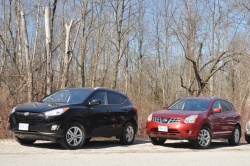 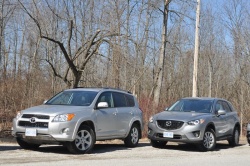  Click image to enlarge |
Originally published on March 20, 2012
Review by Michael Schlee and Jonathan Yarkony; photos by Esmond Yau, Jonathan Yarkony, and Brigitte “The Moderator”
Photo Gallery:
Compact CUV comparo
Related Articles:
First Drive: 2012 Honda CR-V
First Drive: 2013 Mazda CX-5
Test Drive: 2011 Hyundai Tucson GLS AWD
Day-by-Day Review: 2008 Nissan Rogue SL AWD
Used Car Review: Toyota RAV4, 2006-2011
Crossovers are pretty much old hat by now. Almost every manufacturer has abandoned the truck-based body-on-frame sport utility vehicle (SUV) for more advanced unibody construction, which is enough in most books to warrant slapping on the crossover utility vehicle (CUV) label. While the differences are marginal, CUVs offer the high seating position and roomy cargo area of SUVs with a more refined, car-like ride. Some even make all-wheel drive an option rather than a key standard feature. While every segment has seen the introduction of CUVs (from subcompact all the way up to full-size), compact CUVs are the second largest segment by sales (after compact cars), eclipsing even sales of large pickup trucks.
Most manufacturers are in on the segment now, but Toyota and Honda have defined it since they introduced the RAV4 and CR-V, respectively, in the mid-90s. With each generation they have gone head-to-head, leading the segment to prominence as an economical and conscientious option to large SUVs without giving up the creature comforts and utility of those practical transports.
The Honda CR-V was the eighth-bestselling light truck nameplate in Canada last year at just over 25,000, and that was in its final model year, before the introduction of this brand-new 2012 model. With this redesign, Honda again aims to raise the bar and we wanted to see if it still has the Honda mojo that sees the Civic dominate Canadian sales year after year, and the engineering that makes the subcompact Fit the darling of media, though perhaps too pricey for popular tastes.
The Toyota RAV4 is due for its own redesign very shortly, having been on the market in its current form since 2006 with only minor revisions in 2008 and a face-lift in 2011. Despite its age, Toyota sold over 21,000 RAV4s in Canada last year, thanks to variety not offered on many other CUVs, with its optional seating for seven and an optional V6 engine.
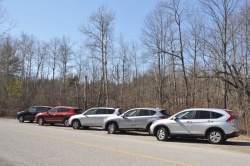 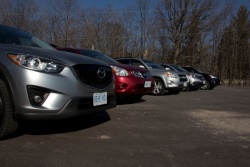 Click image to enlarge |
Of course, the Ford Escape is the Canadian sales champ (by almost 20K units over the CR-V), but the brand new redesigned 2013 Escape is not yet available, so we went looking elsewhere in the talent pool to see who might challenge two of the most recognized household names in the industry. We started with the Nissan Rogue, Nissan’s bestselling model after the Versa line and bestselling utility vehicle by a huge margin, accounting for 14,191 sales for Nissan in 2011. Hyundai sold a similar number of Tucsons in 2011 at 14,309, but no matter how many were sold, we would have included the Tucson, because pretty much everything Hyundai touches is gold these days; we believed the fairly fresh Tucson would be one of the strongest contenders, coming off a significant redesign only a couple years ago.
And last but not least, a brand new model from Mazda, the CX-5, using the firm’s engineering magic that gives us the brilliant MX-5, Mazda3, and Mazda5. Significantly, the CX-5 is the first Mazda to wholly incorporate its new SkyActiv technologies in every facet of vehicle design – from powertrain and chassis right down to suspension and steering – aimed at improving fuel efficiency without compromising driving fun. We had high expectations for the CX-5, because it is a new design that Mazda has had years to contemplate (while selling a rebadged Ford Escape as the Tribute), and because of Mazda’s track record for making fun, functional, and well-packaged vehicles. However, the reason we do these comparison tests is to see who comes out ahead on the road, and not simply in our preconceptions.
Fifth Place – 2012 Nissan Rogue SL AWD
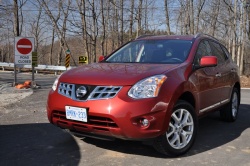 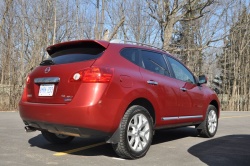 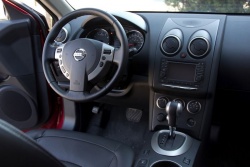 2012 Nissan Rogue SL AWD. Click image to enlarge |
Something had to finish last, and in the case of this comparison test it was the Nissan Rogue. While it finished at the back of the pack in this company, that doesn’t mean that it is not a good car in its own right, as all five CUVs were strong entrants. That being said, it simply wasn’t quite as good as the others in this group. The more we drove these compact crossovers, the more we realized each had its endearing qualities and its sore spots. Unfortunately for the Rogue, its negatives exceeded the other CUVs’ flaws. So what hurt the Rogue the most? In short, it was let down most by its interior and drivetrain.
The interior of the Rogue is a bit of a conundrum. Our fully loaded SL was awash with rich-looking soft-touch materials that were only matched in the CX-5. The overall design of the interior was conservative, to a fault. Despite the great materials, the design looks dated, which makes sense considering this is the second oldest model design in the comparison test. For every great feature like around view monitor parking cameras and standard navigation, there were basic options missing, like a telescopic steering wheel and fold-down rear-seat armrest.
The front seats received much praise for their comfort, but the low placement of the tiny radio/navigation/backup camera screen made viewing it a chore. Another chore was installing a child safety seat: with solid fixed head restraints, the over-the-seat strap had to be finagled to go around the restraint and the cargo-bay LATCH anchor was covered by an unfriendly piece of plastic. Rear cargo space was useful, but at 818 litres was the second smallest, beating only the diminutive Hyundai Tucson.
Off the line, the Rogue is a solid performer thanks to its 170-hp, 2.5-litre four-cylinder engine. The problem is, to extract the full potential out of the Rogue’s engine you must dip heavily into the throttle and allow the continuously variable transmission (CVT) to hold the engine in a high-rpm thrashing cacophony. The CVT in the Rogue is nowhere close to being the worst on the market (that “honour” goes to the Compass), but it is still a CVT and many did not like it. As the only vehicle in the test with a supposedly fuel-saving CVT, it was a bit surprising that it returned the second-worst fuel consumption at an average of 11.8 L/100 km.
It is really too bad that the drivetrain and interior nuances of the Rogue weighed it down so much, since its chassis, exterior styling and rear seat comfort all scored well with the judges and placed it respectably mid-pack in those categories.
Pricing: 2012 Nissan Rogue SL AWD
Base price: $34,278
Options: $135 (Metallic Paint)
A/C tax: $100
Freight: $1,650
Price as tested: $36,163
Manufacturer’s Website:
Nissan Canada














